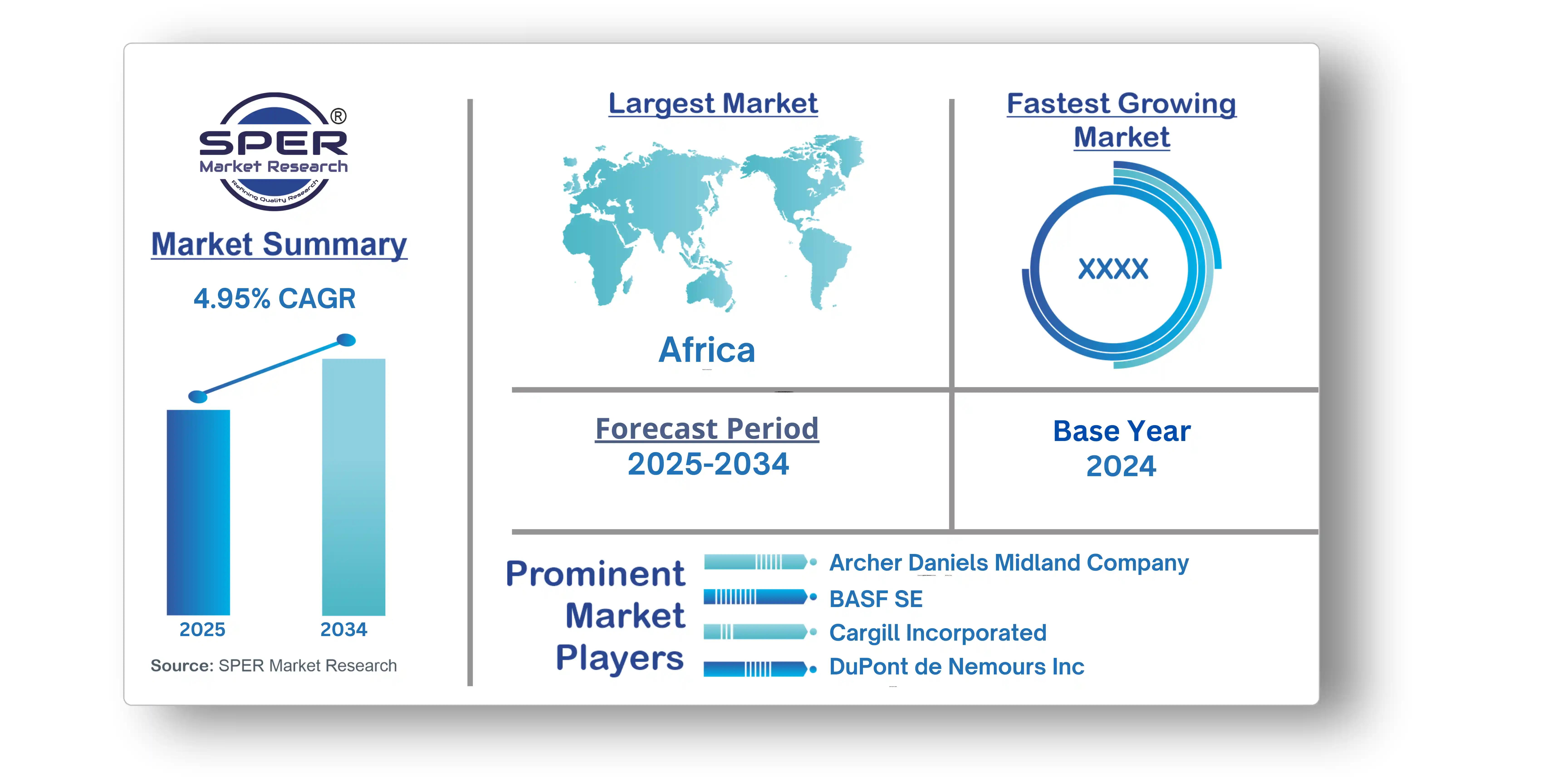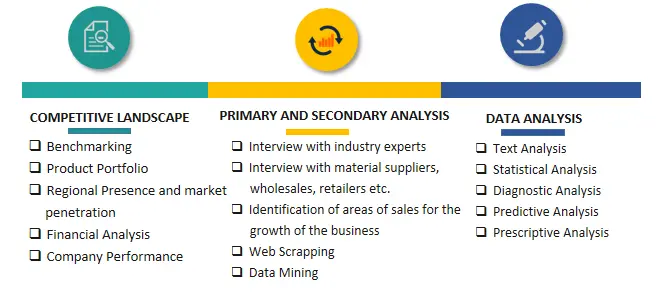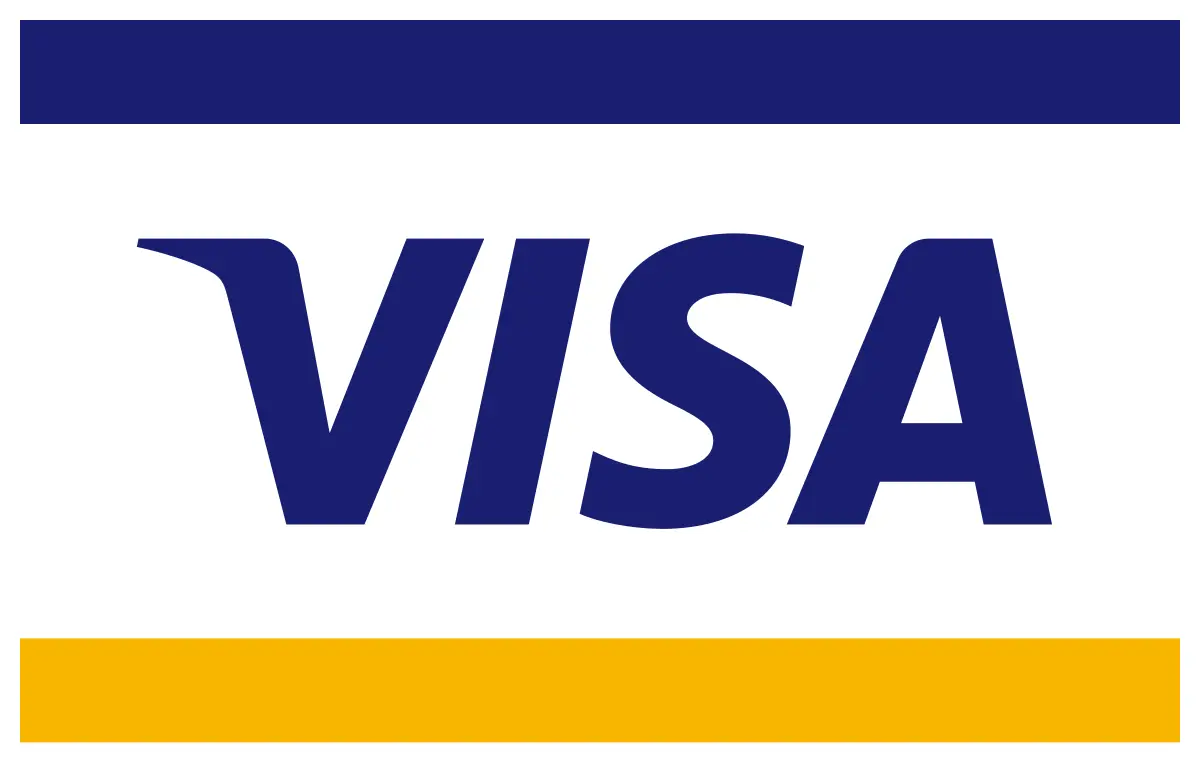
Africa Food Ingredients Market Forecast to 2034
Africa Food Ingredients Market Growth, Size, Trends Analysis - By Ingredients, By Source, By Application - Regional Outlook, Competitive Strategies and Segment Forecast to 2034
| Published: Nov-2025 | Report ID: FOOD25135 | Pages: 1 - 115 | Formats*: |
| Category : Food & Beverages | |||

- In February 2024, Tate & Lyle opened an innovation hub in Nairobi to support East African food manufacturers with formulation and ingredient solutions.
- In November 2023, Kerry Group collaborated with the International Institute of Tropical Agriculture to improve nutrient content in cassava and maize-based foods.
- In October 2023, Sensient Technologies introduced natural food colors from hibiscus and beetroot for clean-label alternatives.
- In April 2023, Promasidor Nigeria reformulated dairy-based drinks to offer low-calorie options using healthier ingredients.
| Report Metric | Details |
|---|---|
| Market size available for years | 2021-2034 |
| Base year considered | 2024 |
| Forecast period | 2025-2034 |
| Segments covered | By Ingredients, By Source, By Application |
| Regions covered | Regions Covered North Africa, South Africa, East Africa, West Africa, Central Africa |
| Companies Covered | Companies Covered Archer Daniels Midland Company, BASF SE, Cargill Incorporated, DuPont de Nemours Inc., Givaudan SA, Ingredion Incorporated, Kerry Group, Novozymes A/S, Olam International, Sensient Technologies Corporation |
- Africa Food Ingredients Market Size (FY’2021-FY’2034)
- Overview of Africa Food Ingredients Market
- Segmentation of Africa Food Ingredients Market By Ingredients (Flavors and flavor enhancers, Sweeteners,Emulsifiers, Colors, Preservatives, Enzymes, Hydrocolloids, Acidulants, Nutritional ingredients, Others)
- Segmentation of Africa Food Ingredients Market By Source (Natural, Synthetic,Nature-identical)
- Segmentation of Africa Food Ingredients Market By Application (Bakery and confectionery, Beverages, Bakery and confectionery, Meat, poultry, and seafood, Snacks and Convenience Foods, Sauces, dressings, and condiments, Infant Food, Others)
- Statistical Snap of Africa Food Ingredients Market
- Expansion Analysis of Africa Food Ingredients Market
- Problems and Obstacles in Africa Food Ingredients Market
- Competitive Landscape in the Africa Food Ingredients Market
- Details on Current Investment in Africa Food Ingredients Market
- Competitive Analysis of Africa Food Ingredients Market
- Prominent Players in the Africa Food Ingredients Market
- SWOT Analysis of Africa Food Ingredients Market
- Africa Food Ingredients Market Future Outlook and Projections (FY’2025-FY’2034)
- Recommendations from Analyst
1.1.Scope of the report1.2.Market segment analysis
2.1.Research data source
2.1.1.Secondary Data2.1.2.Primary Data2.1.3.SPER’s internal database2.1.4.Premium insight from KOL’s
2.2.Market size estimation
2.2.1.Top-down and Bottom-up approach
2.3.Data triangulation
4.1.1.Drivers4.1.2.Restraints4.1.3.Opportunities4.1.4.Challenges
5.1.1.Strengths5.1.2.Weaknesses5.1.3.Opportunities5.1.4.Threats
5.2.1.Political Landscape5.2.2.Economic Landscape5.2.3.Social Landscape5.2.4.Technological Landscape5.2.5.Environmental Landscape5.2.6.Legal Landscape
5.3.1.Bargaining power of suppliers5.3.2.Bargaining power of buyers5.3.3.Threat of Substitute5.3.4.Threat of new entrant5.3.5.Competitive rivalry
7.1.1.Natural flavors7.1.2.Artificial flavors7.1.3.Flavor enhancers7.1.4.Spices and herbs
7.2.1.Natural sweeteners7.2.2.Artificial sweeteners7.2.3.High-intensity sweeteners7.2.4.Bulk sweeteners
7.3.1.Natural emulsifiers7.3.2.Synthetic emulsifiers7.3.3.Lecithin7.3.4.Others
7.4.1.Natural colors7.4.2.Synthetic colors7.4.3.Nature-identical colors
7.5.1.Natural preservatives7.5.2.Synthetic preservatives7.5.3.Antimicrobials7.5.4.Antioxidants
7.6.1.Carbohydrases7.6.2.Proteases7.6.3.Lipases7.6.4.Others
7.7.1.Starches7.7.2.Gums7.7.3.Gelatin7.7.4.Others
7.8.1.Citric acid7.8.2.Lactic acid7.8.3.Acetic acid7.8.4.Others
7.9.1.Proteins7.9.2.Vitamins7.9.3.Minerals7.9.4.Fibers7.9.5.Others
8.1.1.Plant-based8.1.2.Animal-based8.1.3.Microbial8.1.4.Mineral
8.2.1.Artificial flavors8.2.2.Artificial sweeteners8.2.3.Synthetic colors8.2.4.Synthetic preservatives8.2.5.Others
8.3.1.Nature-identical flavors8.3.2.Nature-identical colors8.3.3.Others
9.1.1.Bread and rolls9.1.2.Cakes and pastries9.1.3.Biscuits and cookies9.1.4.Chocolates9.1.5.Sugar confectionery9.1.6.Others
9.2.1.Alcoholic beverages9.2.2.Non-alcoholic beverages9.2.3.Functional drinks9.2.4.Others
9.3.1.Milk products
9.3.3.Yogurt9.3.4.Ice Cream9.3.5.Others
9.4.1.Processed meat9.4.2.Processed poultry9.4.3.Processed seafood9.4.4.Others
9.5.1.Savory snacks9.5.2.Ready-to-eat meals9.5.3.Instant noodles and pasta9.5.4.Others
9.6.1.Table sauces9.6.2.Cooking sauces9.6.3.Dressings9.6.4.Condiments9.6.5.Others
9.7.1.Infant formula9.7.2.Baby food9.7.3.Others
12.1.1.Company details12.1.2.Financial outlook12.1.3.Product summary12.1.4.Recent developments
12.2.1.Company details12.2.2.Financial outlook12.2.3.Product summary12.2.4.Recent developments
12.4.DuPont de Nemours Inc.,12.3.Cargill Incorporated12.3.1.Company details12.3.2.Financial outlook12.3.3.Product summary12.3.4.Recent developments
12.4.1.Company details12.4.2.Financial outlook12.4.3.Product summary12.4.4.Recent developments
12.6.Ingredion Incorporated12.5.1.Company details12.5.2.Financial outlook12.5.3.Product summary12.5.4.Recent developments
12.6.1.Company details12.6.2.Financial outlook12.6.3.Product summary12.6.4.Recent developments
12.7.1.Company details12.7.2.Financial outlook12.7.3.Product summary12.7.4.Recent developments
12.9.Olam International12.8.1.Company details12.8.2.Financial outlook12.8.3.Product summary12.8.4.Recent developments
12.10.Sensient Technologies Corporation12.9.1.Company details12.9.2.Financial outlook12.9.3.Product summary12.9.4.Recent developments
12.11.Others12.10.1.Company details12.10.2.Financial outlook12.10.3.Product summary12.10.4.Recent developments
SPER Market Research’s methodology uses great emphasis on primary research to ensure that the market intelligence insights are up to date, reliable and accurate. Primary interviews are done with players involved in each phase of a supply chain to analyze the market forecasting. The secondary research method is used to help you fully understand how the future markets and the spending patterns look likes.
The report is based on in-depth qualitative and quantitative analysis of the Product Market. The quantitative analysis involves the application of various projection and sampling techniques. The qualitative analysis involves primary interviews, surveys, and vendor briefings. The data gathered as a result of these processes are validated through experts opinion. Our research methodology entails an ideal mixture of primary and secondary initiatives.



Frequently Asked Questions About This Report
PLACE AN ORDER
Year End Discount
Sample Report
Pre-Purchase Inquiry
NEED CUSTOMIZATION?
Request CustomizationCALL OR EMAIL US
100% Secure Payment






Related Reports
Our Global Clients
Our data-driven insights have influenced the strategy of 200+ reputed companies across the globe.























